L.A. Noire
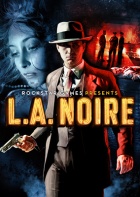

| Game Name: | L.A. Noire |
| Platforms: | Xbox 360, PlayStation 3, PC |
| Publisher(s): | Rockstar Games |
| Developer(s): | Team Bondi, Rockstar Games, Rockstar Leeds (PC) |
| Genre(s): | Open World, Third Person Shooter, Action Adventure |
| Release Date: | May 17 2011 |
| ESRB Rating: | M |
| Big Ups: | Unique experience, great acting, fantastic facial animation, unique gameplay, never feels repetitive |
| Big Downs: | Awkward main storyline twists, weak main storyline, ending that makes you want to punch a puppy |
When you first look at L.A. Noire you notice two things: Rockstar Games and a cop. The second thing that is probably thought is this: “Cool, GTA as a cop in 1940s LA.” That line of thinking is very wrong though. L.A. Noire is vastly different than any game you’d expect to see sporting a Rockstar Games logo. You play a “good” cop, not a sociopathic mass murdering criminal. Development studio, Team Bondi, has pieced together a unique experience closer to that of point and click (or point and vibrate in L.A. Noire’s case) adventure games than a super action packed murderfest.
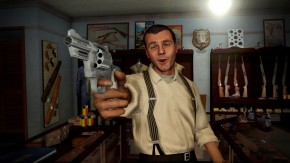 L.A Noire isn’t a snorefest either though. It has its fair share of action sequences. However, the game focuses more on the collection of clues and interrogation of witnesses and suspects. The game tests your abilities to piece together the clues you find or to determine the truth behind an individual’s statements, rather than your ability to shoot some goon in the face. This leads to a much slower and much more emotional experience than is normally seen in most modern games.
L.A Noire isn’t a snorefest either though. It has its fair share of action sequences. However, the game focuses more on the collection of clues and interrogation of witnesses and suspects. The game tests your abilities to piece together the clues you find or to determine the truth behind an individual’s statements, rather than your ability to shoot some goon in the face. This leads to a much slower and much more emotional experience than is normally seen in most modern games.
For the interrogation sequences, Team Bondi needed to get extremely detailed motion capture technology; a technology that could capture the faintest of facial movements from their chosen actors. They found this in a newly developed technology called MotionScan created by the Australian based company, Depth Analysis. This technology records actors using 32 surrounding cameras in order to catch facial movement from every possible angle.
MotionsScan allowed Team Bondi to take the facial animations in L.A. Noire to the next level in order to get the lie reading aspects of the game’s interrogation sequences to work and work well. The end result of this is the best facial animation ever seen in a video game. Every single movement of the actor’s face is caught and emulated making the interrogation sequences feel more realistic. Seeing the emotion in a person’s face is a strong narrative mechanic. However, sometimes they do a little too good of a job on the face. There are several instances in the game where a character’s face looks fantastic and really detailed, but the character’s body looks fuzzy or lacking detail in contrast to the character’s face. These instances were isolated and rare, but when it did happen it was very noticeable.
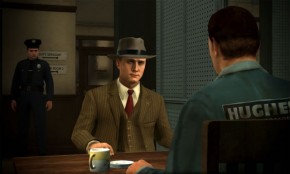 The interrogation sequences are where the real meat of the game is. Most of the interesting dialogue, emotion, and story of L.A. Noire happens during the interrogation sequences, with the rest coming during cut scenes. The acting and dialogue are all phenomenal for the most part. There are a few rare occasions of some overly exaggerated lines, but it doesn’t really detract from the experience. Other than that, L.A. Noire houses some of the best acting I’ve seen in video games and brings a real cinematic feel to the experience.
The interrogation sequences are where the real meat of the game is. Most of the interesting dialogue, emotion, and story of L.A. Noire happens during the interrogation sequences, with the rest coming during cut scenes. The acting and dialogue are all phenomenal for the most part. There are a few rare occasions of some overly exaggerated lines, but it doesn’t really detract from the experience. Other than that, L.A. Noire houses some of the best acting I’ve seen in video games and brings a real cinematic feel to the experience.
The gameplay portion of the interrogation sequences is good at times and really annoying other times. The gameplay mechanic is pretty simple; using your human powers of deduction, you are supposed to watch the NPC’s facial movements and body language to tell if they’re telling the truth or not. Determining if someone is telling the truth or not is generally pretty easy. The annoying part happens when you have to decide between the game’s two separate choices for a character not telling the truth, “Doubt” and “Lie.” The extreme basic definition of the two is that “Doubt” is calling someone a liar when you don’t have evidence to prove it, and “Lie” is calling someone a liar when you actually have evidence to prove they’re lying. There is a handful of sequences when there are seemingly a few options that could prove a lie, but there is only a single correct answer. This tends to make the experience feel a bit more linear. Additionally, there are a few instances where an NPC will respond to a question in a manner where the “Truth” option appears to be the best response. However, selecting “Lie” will give you extra dialogue, and you’re supposed to tell the NPC they’re lying about the extra dialogue, not the original dialogue, in order to get the “correct” response from the NPC. This sounds weird because it is. It is never really hinted that you need to use the “Lie” response as a way to dig out extra dialogue at times. This occasionally causes the awkward situation where the above happens
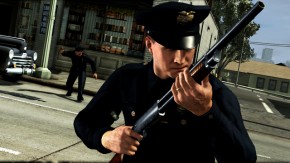 The game isn’t all about Cole shouting at people calling them lying asshats though. You’ll spend a lot of time searching for clues in different environments. Most of these places will have small puzzles hidden in them that have the player doing specific things in order to uncover some hidden evidence. The game uses some not-so-subtle audio hints while you’re scouring the area for unique clues. Additionally, any time you get near an item that can be interacted with, your controller will vibrate. It hurts the immersion factor a bit to have audio and vibration cues, but it doesn’t ever really hurt the overall experience. You never get terribly bored of searching for clues due to the unique presentation of the environments and the cues, which do a good job of pushing you towards the information you need and letting you know when you’re done searching an area.
The game isn’t all about Cole shouting at people calling them lying asshats though. You’ll spend a lot of time searching for clues in different environments. Most of these places will have small puzzles hidden in them that have the player doing specific things in order to uncover some hidden evidence. The game uses some not-so-subtle audio hints while you’re scouring the area for unique clues. Additionally, any time you get near an item that can be interacted with, your controller will vibrate. It hurts the immersion factor a bit to have audio and vibration cues, but it doesn’t ever really hurt the overall experience. You never get terribly bored of searching for clues due to the unique presentation of the environments and the cues, which do a good job of pushing you towards the information you need and letting you know when you’re done searching an area.
L.A. Noire also has a fair amount of action scenes. The game doesn’t put a huge emphasis on action, but generally speaking most cases have a few action sequences and generally end with one as well. These are usually pretty brief and include things like car chases, firefights, running for your life, foot chases, and fist fights. There are two times when you will get into larger scale gunfights; these were really the only action sequences that stuck with me (aside from one instance at the end of the game that would be in the spoiler zone). The mechanics work about as expected for a Rockstar title while the sequences are well paced and placed. They do a good job of only using them when appropriate and enhance the overall experience.
Gameplay isn’t restricted to the main storyline though. L.A. Noire is still a somewhat open world game with side quests and some exploration collectibles (cars and tourist attractions). You’re not allowed to go on a murderous rampage like you can in most Rockstar games, but you are encouraged to respond to dispatch calls, which act as side quests, and to look at the sites that 1940s L.A. has to offer.
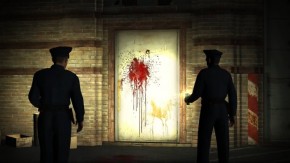 Moving past the gameplay, L.A. Noire has an interesting setup when you start talking about story lines. Each individual case has its own story line. These are often well developed, well paced, and overall very well done. These individual cases and their specific story lines are what makes L.A. Noire such an interesting game. Unweaving the mystery these cases bring forth is always interesting and rewarding. The dialogue really shines in these cases as well, with really good acting and several fairly emotional scenes. The best of these cases is really where L.A. Noire works perfectly and feels like the fantastic game it is.
Moving past the gameplay, L.A. Noire has an interesting setup when you start talking about story lines. Each individual case has its own story line. These are often well developed, well paced, and overall very well done. These individual cases and their specific story lines are what makes L.A. Noire such an interesting game. Unweaving the mystery these cases bring forth is always interesting and rewarding. The dialogue really shines in these cases as well, with really good acting and several fairly emotional scenes. The best of these cases is really where L.A. Noire works perfectly and feels like the fantastic game it is.
The game’s main storyline is somewhat weak comparatively. There are several points in the game where there are just some twists that are so radical and random that they’re hardly believable, while other situations have you asking yourself, “Why should I care about this?” The main perpetrator of the “why should I care” camp is pretty much anything that has to do with Cole Phelp’s character development. While practically every other character in the game has great character development, Cole’s falls short. For example, there is a sequence involving Cole’s wife and children that is probably supposed to invoke some sort of emotion from the player, but you’re never shown Cole’s wife and children in a manner where you ever actually develop any feelings for them at all (hell, his children aren’t even named). They’re mentioned briefly in passing twice before the sequence I’m talking about happens and never noted as of any importance. There is a brief period where Cole’s character development gets pretty good, but just doesn’t do enough before the end of the game.
While the main storyline is interesting, with its focus on internal political corruption, shady businessmen, and other people of dubious personality, it just has way too many awkward twists to really invoke much emotion.
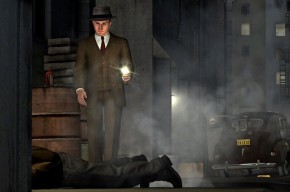 In contrast to the fantastic individual case stories, such as The Golden Butterfly case, the main storyline just seems a bit rushed or like it was less of a focus. The twists just seem so outlandish tha tit really detracts from what the main storyline could have been.
In contrast to the fantastic individual case stories, such as The Golden Butterfly case, the main storyline just seems a bit rushed or like it was less of a focus. The twists just seem so outlandish tha tit really detracts from what the main storyline could have been.
L.A. Noire is a very interesting game that is a great experience for any type of gamer. The core gameplay is very entertaining and satisfying, and the game houses enough content to keep you playing for several days (though you’ll never want to put the game down). Even though the main storyline is a little weak, when coupled with the fantastic individual cases it houses some of the most unique and emotional experiences I’ve had the pleasure of enjoying in this console generation.
For the spoilery opinions of L.A. Noire from Chance and Travis listen to the spoilercast at the end of InDis Episode 181!
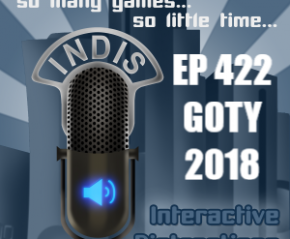







[…] My L.A. Noire review is finally live over at Interactive Distractions, click HERE for […]